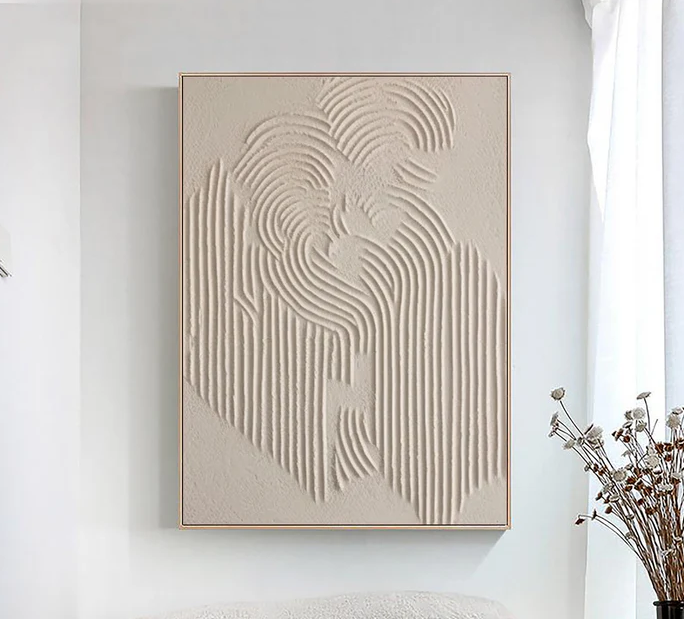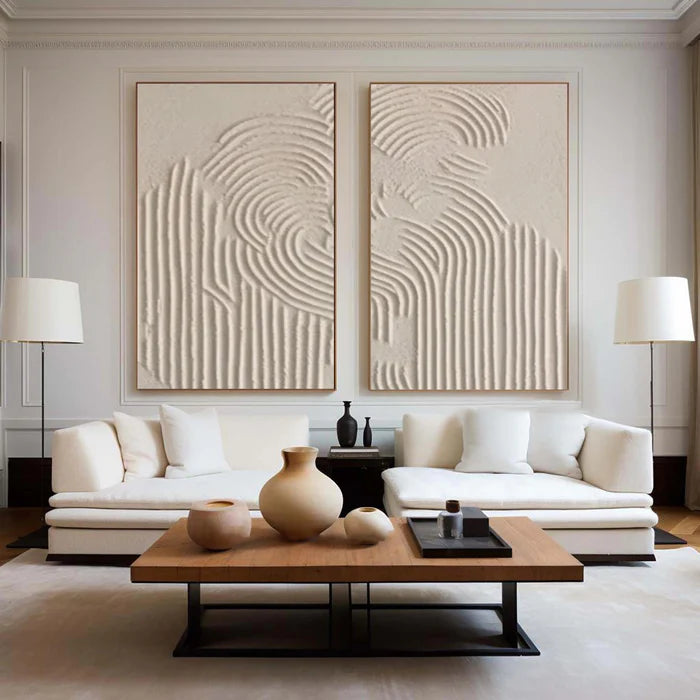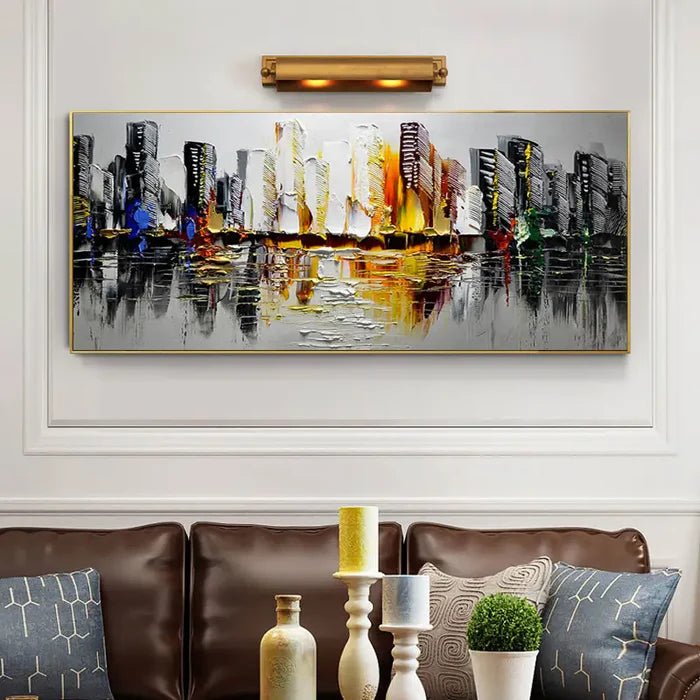Article: What Is Wabi Sabi Art? Get Appealing Art Paintings for Space Decor

What Is Wabi Sabi Art? Get Appealing Art Paintings for Space Decor
Do you think a cracked vase holds more charm than a pristine one? Wabi sabi art embraces this idea – finding elegance in imperfection. This kind of art finds profound beauty in natural shapes, understated textures, and the patina of age. Discover how the art of wabi sabi can bring tranquility and authenticity to your art collection and space.
What is wabi sabi art?
It is a multifaceted Japanese philosophy that celebrates the beauty within the imperfect, the impermanent, and the incomplete. It guides us toward a profound appreciation for the uniquely authentic and invites us to find wonder within humble objects, savour the textures wrought by time, and discover an unexpected elegance in the flawed and the weathered.
Rooted in the principles of Zen Buddhism, this aesthetic philosophy encourages us to accept life’s transient nature, to see beyond the pursuit of polished perfection, and to cherish the poignant beauty of the unassuming.
In a world that mainly values the pristine and the flawless, It nudges us back to authenticity, reminding us that imperfection holds its own charm.
To fully appreciate wabi sabi art, it is important to understand the seven principles of this aesthetic:
- Kanso: Simplicity, the beauty of the unadorned.
- Fukinse: The asymmetry and irregularity found in natural forms.
- Shibumi: Subdued beauty or understated elegance.
- Seijaku: Tranquility drawn from stillness and contemplation.
- Shizen: Naturalness, a sense of non tempered authenticity.
- Datsuzoku: Unconventional, free from norms.
- Yugen: heartfelt mystery, an evocation of the unseen depths.
Wabi sabi emerged in the 15th century, at a time of opulent and highly decorative trends. Pioneers of wabi sabi like tea master Murata Juko championed a new aesthetic by promoting simple tea ceremonies with rustic utensils. It became intertwined with Zen Buddhism and remains a relevant aesthetic philosophy today, offering people a path to finding joy in life’s understated beauty.
In the modern world, wabi sabi has transcended traditional Japanese tea ceremonies and art. It influences contemporary art, where artists incorporate natural materials and asymmetry to evoke a sense of quiet reflection. It is also incorporated into interior design by embracing weathered textures, organic forms, and worn furnishings.
Wabi sabi has also become a personal philosophy for some, living a lifestyle focused on authenticity and mindful appreciation of every day.
It’s hard to talk about art without thinking about color. Anything inspired by the wabi sabi style draws from the natural world. So when you think of a wabi sabi color palette, think of earth tones (sandy beiges, muted browns, rusts), ocean and sky (pale blues, muted greens, weathered greys), natural pigments (blacks, umber, ochres), and subtle metallics (aged bronze, oxidized copper). Wabi sabi colors foster a sense of serenity and grounding.
Wabi sabi is not just about aesthetics, it’s a perspective. By developing a wabi sabi eye, we discover beauty in the unassuming, joy in the simple, and, most importantly, peace within the imperfect flow of life.
With a basic understanding of wabi sabi and its core principles, it’s time to see some good examples of wabi sabi art paintings
Examples of wabi sabi art painting
Ready to see wabi sabi in action? The following examples of paintings embody the principles we’ve discussed. Observe how texture, natural elements, and a touch of asymmetry create soothing art.
Blue & Green Abstract

This blue & green abstract embodies the essence of wabi sabi through organic textures, a muted color palette, and a sense of quiet mystery. Swirls of cool blues and greens evoke the weathered beauty of a seascape. The textured brush strokes create a tactile surface that beckons your gaze. This masterpiece of imperfect beauty is ideal for living rooms, bedrooms, and meditation areas. It pairs well with soft natural textured surfaces and uncluttered decor.
Wabi Sabi Beige & Brown Abstract

Wabi Sabi Beige & Brown Abstract, that captures the wabi sabi spirit by embracing raw beauty.
A symphony of earthy browns dances across the canvas, their rough textures reminiscent of volcanic landscapes or weathered canyons. This piece pulsates with the energy of nature, making it a perfect statement piece for living rooms, studies, and entryways. Pair it with natural materials like wood, stone accents, or a touch of greenery for a sophisticated ambience.
Green & Beige Wabi Sabi Wall Art

Green and Beige Wabi Sabi Wall Art, A masterpiece of sandy beige, textured like a shoreline caressed by gentle waves.
It embodies wabi-sabi, celebrating the beauty in imperfection and transient moments.
The weathered appearance and organic forms evoke a sense of timeless tranquility as if the ocean itself has been captured on the canvas. It invites quiet contemplation, making it perfect for meditation spaces, bedrooms, and living rooms. The piece would pair well with soft natural fabrics, seashells, and other ocean-inspired objects for a harmonious and calming aesthetic.
Feeling Inspired?
Are you feeling inspired by the beauty of imperfection? You can bring the essence of wabi sabi into your own decor. In the next section, we’ll explore some simple steps and techniques to create your own DIY wabi sabi art.
How to DIY wabi sabi art?
Ready to embrace wabi sabi, the art of imperfection? Here is a simple guide on how to make wabi sabi art.
For DIY wabi sabi art, you need the following materials:
- Canvas or textured surface: A stretched canvas works, but you can get more creative and use rough paper, pre-textured substrates, or wood panels.
- Acrylic paints: Use acrylic paints in muted earth tones, blues, grays, and greens.
- Texture mediums: To add depth to your art, use texture mediums like sand and modelling paste.
- Natural elements: You can get more creative by incorporating natural elements like small stones and dried leaves.
- Tools: You’ll need tools like old brushes and palette knives. For a more organic feel, use your bare hands.
Here are some simple steps to follow to create DIY wabi sabi art:
- Embrace freedom: Wabi sabi is the art of imperfection. So, do not overthink it; just start.
- Build texture: Mix your preferred texture medium with some acrylic paint to create a rough base layer and apply it evenly on the canvas.
- Layer colors: Choose a muted color palette, then blend and layer the colors for depth. You should avoid precision.
- Add natural elements: If you are willing to push the boundaries of creativity, scatter sand or press a leaf into the wet paint on the canvas. Allow your intuition to guide you.
- Leave it to dry: As the piece dries, the imperfections will be more apparent, adding to the charm of your DIY wabi sabi art.
For more inspiration, follow Vinchyart’s artists to DIY an awesome wabi sabi art!
If you’re looking for ready-made wabi sabi art pieces, Vinchy art has a wide collection created by skilled artists. Explore a variety of textures, colors, and compositions inspired by the Japanese philosophy of wabi sabi.
Introduce the Wabi-Sabi Style into your space
The Japanese philosophy of embracing imperfection and authenticity, can transform your living space into a sanctuary of tranquility and warmth. This aesthetic philosophy celebrates the beauty that lies within the simple, weathered, and naturally occurring.
Here’s how to introduce the wabi sabi style into your interior design.
Natural textures

Natural textures are the heart of wabi sabi. Introduce the wabi-sabi style into your space using organic materials. Think along the lines of rough-hewn wood furniture with visible grain, woven linen throws, and ceramic vases with naturally occurring glaze variations.
Nature-inspired calming palette

A color scheme draws inspiration from nature, earth, sky, plants, etc. Think soft beige, muted greens, weathered blues, and earthy terracotta. These colors work well as backdrops, allowing the center of focus to be on the textures and forms. They also harmonize beautifully with natural materials.
Cherished objects that tell a story

Viewed through a wabi sabi lens, every object in your home could tell a story. Embrace wabi sabi’s principle of imperfection by displaying a chipped heirloom teacup, a rustic wooden bowl from a trip to Asia, or a faded tapestry from a flea market. Place such objects where their imperfections can add unique beauty and be appreciated.
Maximize natural light

Natural light can transform the way a room looks and feels. And if the room is wabi sabi-styled, natural light reveals the subtle imperfections and highlights the textures. Go for breezy window coverings, sheer curtains, mirrors to create the illusion of more light, or no window coverings at all.
Wabi Sabi wall art & paintings for sale
Are you looking to buy wabi sabi wall art or paintings? Vinchyart has curated a stunning collection of wabi sabi paintings that embody the principles of this timeless aesthetic. Each piece celebrated the beauty of imperfection, natural textures, and muted color palettes, the right fit for those seeking a tranquil atmosphere in their homes or even workplaces.
The pieces in our collections are unique works of art by skilled artists. The paintings are made from high-quality materials, and the visual details align with the wabi sabi philosophy. The store’s growing popularity is a testament to its professionalism and the quality of wabi sabi art gallery.
Visit the online store now to browse the vast wabi sabi art collections.
FAQs
Is Wabi Sabi artwork only suitable for homes with a Japanese decoration style?
Absolutely not! While inspired by Japanese aesthetics, wabi sabi art seamlessly blends into various design styles. It adds a touch of serenity to modern designs, warmth to minimalist interiors, and a grounding element to homes with a broad range of designs. To see how diverse wabi sabi art can be, explore Vinchy art’s collections.
Can Wabi Sabi be applied to office spaces?
Yes. The calming nature and focus on natural elements make wabi sabi well-suited for office environments. It helps in creating a less distracting and more balanced workspace, promoting concentration and a sense of well-being.
To enhance your workspace with a touch of wabi sabi art beauty, browse our collection of office-appropriate wabi sabi abstract art pieces.
What are the colors for a wabi-sabi bedroom?
A wabi sabi style bedroom prioritizes tranquility. For that reason, the colors are soft neutrals, warm earth tones, and muted blues and greens. To add warmth to the tranquility, linen whites and warm grays. Find the perfect piece of wabi sabi art painting to serve as the focal point of your wabi sabi style bedroom at the Vinchy art online store.
What is the difference between wabi-sabi and minimalism?
While both styles share an appreciation for simplicity, wabi sabi focuses on embracing imperfection, natural textures, and the beauty of wear and tear. Minimalism strives for a more sleek and polished aesthetic, prioritizing pristine lines and a neutral palette. If you are a lover of simplicity but crave a touch of organic warmth, wabi sabi-inspired art on Vinchyart might resonate with you.
What style is similar to wabi-sabi?
Styles like Scandinavian, Rustic, and Japandi share common themes with wabi sabi. They often feature natural materials, muted palettes, and a focus on functionality and simplicity. If you enjoy these aesthetics, you'll likely appreciate the beauty of wabi sabi as well. Explore the Vinchyart collections and discover wabi sabi art pieces to complement the styles you already love.


